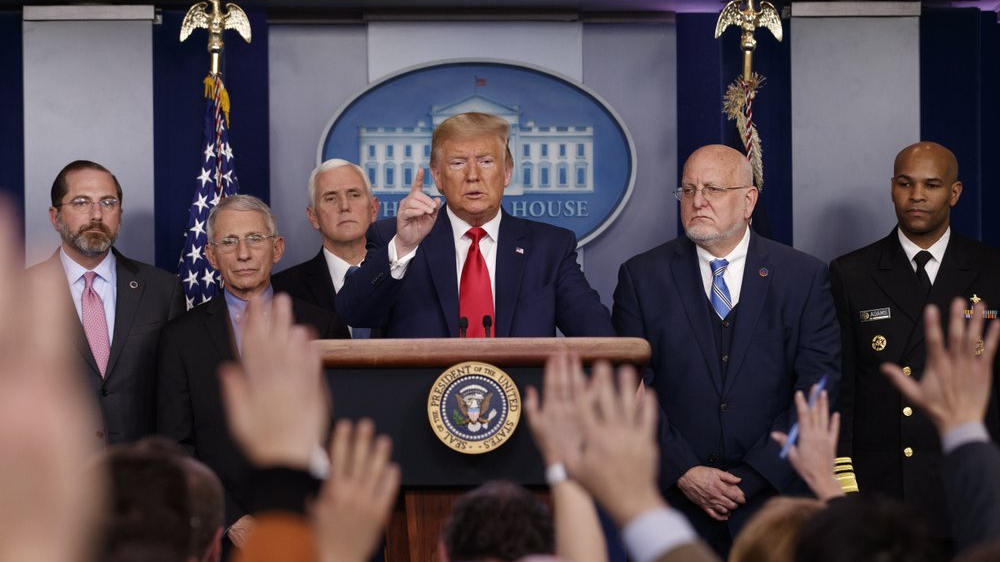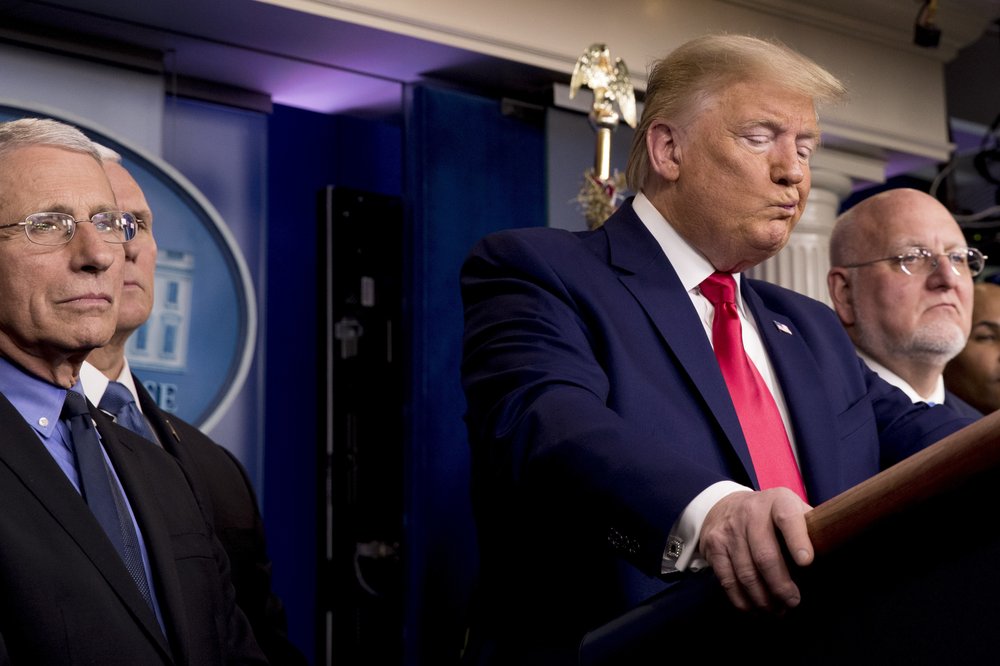
President Donald Trump (C) points as he prepares to answer questions after speaking about the coronavirus in the press briefing room at the White House in Washington, DC, February 29, 2020. /AP
President Donald Trump (C) points as he prepares to answer questions after speaking about the coronavirus in the press briefing room at the White House in Washington, DC, February 29, 2020. /AP
Public health officials were already warning Americans about the need to prepare for the coronavirus threat in early February when there was just 11 cases confirmed in the United States, and when President Donald Trump called it "deadly stuff" in a private conversation.
There was uncertainty about how the U.S. ultimately would be affected, and top U.S. officials would deliver some mixed messages along the way. But their overall thrust was to take the thing seriously.
"We're preparing as if this is a pandemic," Dr. Nancy Messonnier of the Centers for Disease Control and Prevention (CDC) told reporters on February 5. "his is just good commonsense public health."
Trump, however, had a louder megaphone than his health experts, and in public he was playing down the threat. Three days after delivering his "deadly" assessment in a private call with journalist Bob Woodward, he told a New Hampshire rally on February 10, "It's going to be fine."
Trump's acknowledgment in Woodward's new book "Rage" that he was minimizing the severity of the virus in public to avoid causing panic has triggered waves of criticism that he wasn't leveling with the American people.
The White House has tried to answer that criticism by pointing to selected comments from U.S. health experts to suggest they were on the same page with Trump all along.
White House press secretary Kayleigh McEnany highlighted comments from Dr. Anthony Fauci, the nation's top infectious disease expert, to try to make the case that Trump didn't lie to the public. She cited a February 17 interview in which Fauci focused his concern on the seasonal flu then playing out.

President Donald Trump, accompanied by, National Institute for Allergy and Infectious Diseases Director Dr. Anthony Fauci (1st L), Vice President Mike Pence(2nd L) and Robert Redfield, director of the Centers for Disease Control and Prevention, reacts to a question during a news conference on the coronavirus in the press briefing room at the White House in Washington, DC, February 29, 2020 /AP
President Donald Trump, accompanied by, National Institute for Allergy and Infectious Diseases Director Dr. Anthony Fauci (1st L), Vice President Mike Pence(2nd L) and Robert Redfield, director of the Centers for Disease Control and Prevention, reacts to a question during a news conference on the coronavirus in the press briefing room at the White House in Washington, DC, February 29, 2020 /AP
But a day later, Fauci had spoken of alarming potential implications from the new virus, saying, "Not only do we not have an appreciation of the magnitude, even more disturbing is that we don't have an appreciation of where the magnitude is going."
Mixed safety messages added to confusion. There was considerable discussion about mask-wearing in the early days of the pandemic, with leading experts advising the public against it, saying to leave the masks for health care workers.
"Seriously people – STOP BUYING MASKS!" U.S. Surgeon General Jerome Adams tweeted on February 29. Officials later recommended that people wear face coverings in public and around people who don't live in their household, based on a review of the latest evidence.
People could find different takeaways within Fauci's pronouncements. He told the USA Today editorial board on February 17 that the CDC would be testing people for the coronavirus in five major cities when they showed up at clinics with flu-like symptoms.
If that testing showed the virus had slipped into the country in places federal officials didn't know about, "we've got a problem," Fauci said. Still, the headline put the spotlight on his remark that the danger posed by the virus was slight. It read: "Top disease official: Risk of coronavirus in USA is 'minuscule.'"
Larry Gostin, a professor at Georgetown University who has advised Republican and Democratic administrations on public health issues, said there should be no confusing honest mistakes and expressions of uncertainty from public health officials with Trump's effort to minimize the threat of COVID-19.
"It is irrefutable that he has played down the epidemic and sidelined trusted scientists, and in some cases, muzzled them," Gostin said.
He added: "I categorically deny the idea that there wasn't a strong consensus of public health experts at the time saying this was a very serious problem."
Trump himself told Woodward on March 19 that he had deliberately minimized the danger. "I wanted to always play it down," the president said. "I still like playing it down because I don’t want to create a panic."
Critics have long noted how Trump's public comments failed to sync up with those of public health officials, contributing to confusion among Americans.
As Trump left for India on February 23, he told reporters that the virus was "very much under control" and that the small number of infected people in the U.S. were "very well confined."
But two days later, the CDC's Messonnier told reporters, "It's not so much a question of if this will happen anymore, but more really a question of when it will happen and how many people in this country will have severe illness."
Dr. Howard Koh of Harvard's school of public health said unflinchingly communicating what's known as soon as possible helps build trust that will be necessary as the pandemic progresses.
Koh said the role of the White House in a pandemic is to galvanize national attention for public health officials and then step out of the way. But that hasn't been the case under Trump, said Koh, who was at the Department of Health and Human Services under President Barack Obama.
Source(s): AP